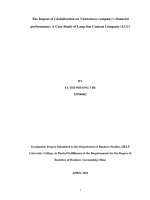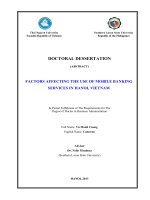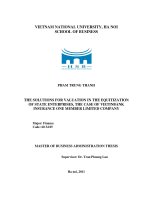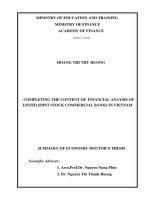Completing The Auditing Of Administrative Expenses In Financial Statements Auditing By Branch Of Auditing & Informatics Services Company Limited In Da Nang (Aisc).Pdf
Bạn đang xem bản rút gọn của tài liệu. Xem và tải ngay bản đầy đủ của tài liệu tại đây (15.08 MB, 142 trang )
DUY TAN UNIVERSITY
INTERNATIONAL SCHOOL
TRAN THI NHU QUYNH
COMPLETING THE AUDITING OF
ADMINISTRATIVE EXPENSES IN AUDITING
FINANCIAL STATEMENTS BY BRANCH OF
AUDITING & INFORMATICS SERVICES COMPANY
LIMITED IN DA NANG (AISC) FOR ABC JOINT
STOCK COMPANY
UNDERGRADUATE THESIS
ACCOUNTING AND AUDITING
Da Nang, 2021
DUY TAN UNIVERSITY
INTERNATIONAL SCHOOL
UNDERGRADUATE THESIS
COMPLETING THE AUDITING OF
ADMINISTRATIVE EXPENSES IN AUDITING
FINANCIAL STATEMENTS BY BRANCH OF
AUDITING & INFORMATICS SERVICES COMPANY
LIMITED IN DA NANG (AISC) FOR ABC JOINT
STOCK COMPANY
SPECIALIZATION: ACCOUNTING AND AUDITING
INSTRUCTORS : ASSOC. PROF. PHD PHAN THANH HAI
STUDENT
: TRAN THI NHU QUYNH
CLASS
: K23PSU KKT1
STUDENT CODE : 2320253527
Da Nang, 2021
ACKNOWLEDGEMENT
I also sincerely thank Assoc. Prof. PhD. Phan Thanh Hai for helping a lot
in completing the graduation thesis in the best way, thank you, the staff and
employees of the Branch of Auditing and Informatics Services Company
Limited in Da Nang (AISC) has created many opportunities to experience
practical, accumulate more experience. We would like to wish the teachers
and the staff and employees of the Branch of Auditing and Informatics
Services Company Limited in Da Nang (AISC) good health and success at
work. Wish your company business more and more efficient. Thank you
sincerely.
Da Nang, 2021
Student
(Signature and Full name)
Tran Thi Nhu Quynh
TABLE OF CONTENT
TABLE OF ABBREVIATIONS
LIST OF TABLES
LIST OF DIAGRAM
ABSTRACT ......................................................................................................... 1
INTRODUCTION ................................................................................................. 2
CHAPTER 1. THEORETICAL BASIS FOR AUDIT ADMINISTRATIVE EXPENSES
IN AUDITING FINANCIAL STATEMENTS UNDER THE SAMPLE AUDIT
PROGRAM PROVIDED BY VACPA ..................................................................... 4
1.1. BASIC ISSUES RELATED TO ADMINISTRATIVE EXPENSE ........................ 4
1.1.1. An overview of the administrative expenses ................................................. 4
1.2. ADMINISTRATION EXPENSES ON AUDITING FINANCIAL STATEMENTS11
1.2.1. Administrative expenses audit goal ........................................................... 11
1.2.2. Internal control for administrative expense ................................................. 12
1.2.3. Common risks and mistakes when auditing administrative expenses................... 12
1.2.4. Administrative Expense audit process in Financial Statement ........................ 13
1.3. IMPLEMENTING ADMINISTRATIVE EXPENSE AUDIT UNDER VIETNAM
STANDARDS ON AUDITING VACPA ................................................................ 14
1.3.1. Profile index ......................................................................................... 14
1.3.2. Content audit administrative expenses items ............................................... 14
CHAPTER 2. AUDIT STATUS OF THE ADMINISTRATION EXPENSE IN THE
FINANCIAL STATEMENT AUDIT PERFORMED BY BRANCH OF AUDITING &
INFORMATICS SERVICES COMPANY LIMITED IN DA NANG (AISC) ............. 23
2.1. AN OVERVIEW OF BRANCH OF AUDITING & INFORMATICS SERVICES
COMPANY LIMITED IN DA NANG (AISC) ........................................................ 23
2.1.1. History of formation and development ...................................................... 23
2.1.2. The field of operation ............................................................................. 25
2.1.3. Organizational Structure ......................................................................... 31
2.1.4. Customer policy of AISC ........................................................................ 35
2.2. STATUS OF AUDITING ADMINISTRATIVE EXPENSES IN AUDITING
FINANCIAL STATEMENTS BY AISC ................................................................ 35
2.2.1. Audit Planning ...................................................................................... 35
2.2.2. Audit Performing................................................................................... 43
2.2.3. Audit Ending ........................................................................................ 56
CHAPTER 3. A SOLUTION TO COMPLETE THE ADMINISTRATIVE EXPENSES
IN FINANCIAL STATEMENT AUDIT IS IMPLEMENTED BY BRANCH OF
AUDITING & INFORMATICS SERVICES COMPANY LIMITED IN DA NANG .. 59
3.1. GENERAL ASSESSMENT ON BRANCH OF AUDITING & INFORMATICS
SERVICES COMPANY LIMITED IN DA NANG (AISC)......................................... 59
3.1.1. Advantages........................................................................................... 59
3.1.2. Disadvantages ....................................................................................... 60
3.2. COMMENTS ON THE AUDITING OF ADMINISTRATIVE EXPENSES AT
ABC JOINT STOCK COMPANY ........................................................................ 60
3.2.1. Advantages........................................................................................... 61
3.2.2. Disadvantages ....................................................................................... 63
3.3. SOLUTIONS TO RECOMMEND TO COMPLETE THE AUDITING OF
ADMINISTRATIVE EXPENSES IN AUDITING FINANCIAL STATEMENTS ...... 64
3.3.1. Some solutions to complete the general situation of AISC ............................ 64
3.3.2. Some recommendations to complete the auditing Administrative Expenses ..... 65
CONCLUSION ................................................................................................... 79
LIST OF BIBLIOGRAPHY
LIST OF APPENDICES
TABLE OF ABBREVIATIONS
AISC
Auditing and Informatic Services Company Limited
VACPA
Vietnam Asociation of Certified Public Accountants
VSA
Vietnam Standards on Auditing
MANAGEMENT ASSERTIONS
A = Accuracy
C = Completeness
Classification = Classification
E = Existence
O = Occurrence
P&D = Presentation and Disclosure
R&O = Right and Obligation
V = Valuation
LIST OF TABLES
Number
Table Name
Page
2.1
Materiality assessment
38
2.2
Determination of sample distance
39
3.1
Reference about research the internal control system
66
3.2
Comparison of old and new VACPA sample auditing
programs (account 642)
67
3.3
New audit program form
69
3.4
New G450 working paper
73
LIST OF DIAGRAM
Number
Diagram Name
Page
1.1
The T of Account 642
10
1.2
Audit process
13
2.1
Organizational structure of AISC
32
2.2
Organizational structure of Da Nang Branch
33
ABSTRACT
In financial information, administrative expenses are highly sensitive
indicators that important role in the company's income statement affecting the
profitability and corporate income tax, and some other indicators on the
financial statement. Therefore, the process of auditing on selling and
administrative expenses is necessary. I chose this topic to understand more
about the auditing on the selling expenses and administrative expenses,
specifically performed by the Branch of Auditing & Informatics Services
Company Limited in Da Nang (AISC). The thesis consists of three chapters:
Chapter 1: Theoretical basis for administrative expenses in auditing
financial statements under the sample audit program provided by VACPA.
This chapter focused on the following issue: learning about item
administrative expenses in a financial statement; process auditing on
administrative in the audit of the financial statements.
Chapter 2: Audit reality of administrative expenses in the financial
statement audit performed by Branch of Auditing & Informatics Services
Company Limited in Da Nang (AISC).
Research the following issues: learn about Branch of Auditing &
Informatics Services Company Limited in Da Nang (AISC), process auditing
for administrative expenses in financial statements audit performed by Branch
of Auditing & Informatics Services Company Limited in Da Nang (AISC) for
customer ABC in 2020.
Chapter 3: A solution to complete administrative expenses in financial
statement audit is implemented by the Branch of Auditing & Informatics
Services Company Limited in Da Nang (AISC).
Although the process auditing of the administrative expenses has many
advantages, there are many disadvantages. Therefore, I would like to make
some suggestions for AISC to complete the process auditing of the
administrative expenses in the audit of the financial statements.
1
INTRODUCTION
Since its inception until today, the audit industry has grown rapidly in
Vietnam, contributing to making the financial information of the business
available to its users accurate and transparency, serving the general interests
of users inside and outside the business.
As a part of the economy, the formation and development of the market
for accounting and auditing services are both objective inevitable; both are an
important component of the system of macroeconomic - financial management
tools and play an active role in socio-economic development. Stemming from
such essential benefits of accounting and auditing services, in recent years,
auditing activities in general and independent auditing activities, in particular,
have not stopped improving and developing, and asserted their firm position in
the region and the world. That is the indispensable development trend of an
innovative economy and is on the rise like our country in the current period.
Auditing of financial statements is a combination of the results of the
various operations and cycles, from the audit planning stage to the end of the
audit and report release. For the majority of companies these days, the
administrative expense is a very important part of the administrative. This is a
material item, directly affecting the revenue and profit of the company,
thereby falsifying the data presented on the financial statements, affecting the
decisions of users. Therefore, the audit of administrative expenses is extremely
important in every audit of the financial statements at the enterprise.
Recognizing the importance of the item of corporate administrative
expenses in auditing financial statements and through the knowledge and
experience accumulated in the process of studying and training at the
University as well as the internship at Branch of Auditing & Informatics
Services Company Limited in Da Nang (AISC), I chose the topic:
“Completing The Auditing of Business Administrative Expenses in Auditing
2
Financial Statements by Branch of Auditing & Informatics Services Company
Limited in Da Nang (AISC) for ABC Joint Stock Company”.
The content of the thesis consists of 3 main chapters as follows:
Chapter 1: Theoretical basis for Administrative Expenses in auditing
financial statements under the sample audit program provided by VACPA.
Chapter 2: Audit reality of Administrative Expenses in the financial
statement audit performed by Branch of Auditing & Informatics Services
Company Limited in Da Nang (AISC).
Chapter 3: A solution to complete Administrative Expenses in financial
statement audit is implemented by the Branch of Auditing & Informatics
Services Company Limited in Da Nang (AISC).
3
CHAPTER 1
THEORETICAL BASIS FOR AUDIT ADMINISTRATIVE EXPENSES
IN AUDITING FINANCIAL STATEMENTS UNDER THE SAMPLE
AUDIT PROGRAM PROVIDED BY VACPA
1.1. BASIC ISSUES RELATED TO ADMINISTRATIVE EXPENSE
1.1.1. An overview of the administrative expenses
1.1.1.1. Notion
Administration expenses are the monetary cost of labor waste spent by
an enterprise to perform management tasks, including business management,
administrative management, and other management.
Administrative expenses include general management costs of the
enterprise, including salary costs for employees of the enterprise management
department (salaries, wages, allowances,...); social insurance, health insurance,
trade union funds, unemployment insurance of the enterprise managers;
stationery cost, labor tools, fixed asset depreciation for corporate management;
land rent, license tax; the provision for bad debts; outside purchasing services
(electricity, water, telephone, fax, property insurance, fire,... ); Other costs
(reception, customer conference,... ).
Administration expenses that are not considered business income taxliable charge under the law on taxation but have sufficient invoices and
documents and have been properly accounted for according to the accounting
regime are not allowed to be recorded as a decrease in expenses. Accounting
fees that only adjust in the finalization of business income tax charge to
increase business income tax charge payable.
Account 642 is opened in detail for each expense item as prescribed.
Depending on the management requirements of each industry or enterprise,
account 642 can be opened with second-level accounts to reflect the cost
contents of administrative expenses. At the end of the period, the accountant
4
transfers administrative expenses to the debit side of account 911 "Evaluation
of business results".
1.1.1.2. Characteristics, role, and method of establishment of administrative
expenses on the financial statements
a. Characteristics
Enterprise management fee is an expense that is often related to running
enterprise-wide production and business. Including costs of management
materials, office supplies - a depreciation of fixed assets for the whole
enterprise, taxes, management staff expenses, reception expenses, conferences,
non-business fees. In terms of nature, administration expenses are expenses for
indirectly serving production and business activities. It ensures that the
production and business activities of the business are conducted in a normal
way. These are relatively stable costs.
Through the above content along with the concept of administrative
expenses, it can be seen that includes many different costs, those costs are
indirectly contributing to participating in production activities for businesses
but have a very large role because they participate in the process of consuming
and manufacturing products as well as the management apparatus of the
business.
Basic accounting principles and requirements in recognizing the
elements in the financial statements are truthful, reasonable, and legal. For the
accounting of administrative expenses, it is necessary to focus on the
following principle:
- Consistency Principle: Principles and methods applied by the
enterprise must be consistent within a fiscal year such as depreciation policy,
amortization policy.
- Conservatism
Principle:
Conservatism
is
the
consideration,
consideration, and judgment necessary to make accounting estimates in terms
of uncertainty. Thus, the accountant must immediately reflect the cost when
5
there is evidence of the possibility of the cost and not be reflected below or
higher than the actual value of that expense.
- Matching Principle: Recognition of revenue and expenses must match
each other, that is when recognizing an amount of revenue, at the same time
recording an expense related to the generation of that revenue.
- Materiality Principle: Information is considered materiality if the lack
of information or the inaccuracy of such information significantly falsifies the
information presented in the financial statements, affecting the decisions of
users of the information on the financial statements.
- Accounting period Principle: Expenses incurred in any period, the
business will account in that period.
- Cost Principle: Administrative expenses are accounted for according
to the actual expenses that the business spends, regardless of the market price,
pay attention to the distribution of expenses between periods.
b. Role
Administrative expenses are indirect costs that play a decisive role in the
existence and impact of an enterprise. Without a general and administrative
department, the business will not be able to orient, not determine whether the
products are really what the market needs, but it plays a role in accelerating
production more quickly. Thus, administrative expenses are a very important
cost in the business. So the cost to maintain the operation of this department is
inevitable that businesses must bear.
In addition, administrative expenses are influential in the evaluation of
business results, corporate income tax payable on the income statement.
c. Influence of administrative expenses in auditing financial statements
Auditing the administrative expenses is an important part of the audit of
financial statements. The administrative expenses have an important feature:
they are indirect costs to the production process but are a direct indicator of
taxable income. Specifically:
6
- The cost items on the income statement are important indicators
reflecting the overall business process of the business in the period.
Administrative expenses seriously affect the income statement. Incorrectly
reflected administrative expenses will change pre-tax profit, profit tax, and
profit after tax seriously to the income statement, leading to data in the income
statement not truthfully reflect the results of production and business activities
of the enterprise. All errors related to cost reflection have a direct impact on
the evaluation of business results.
- Administration expense also affects balance sheet items. A big change
in costs will change the balance of the profit account, tax payable...
- Administrative expenses incurred are often related to short-term
payables or payables that are factors with high fraud potential.
- For the budget, the cost indicators are one of the bases for determining
taxable income, so it always requires the accounting unit to comply with the
regulations, which also requires auditors to be conservatism when auditing
these items if they do not want their customers to have tax arrears because of
unreasonable and valid cost accounting.
- Administrative expenses are closely related to consumption in a
business, it includes very sensitive costs, depending on the characteristics of
production and business and management characteristics of each business.
Checking the correctness in the collection, classification, and recognition of
corporate management costs not only helps the auditor to comment on
consumption and management in the business, helping to advise the business
to improve the administrative expenses but also as the basis for auditors to
assess the reliability of financial statements of enterprises.
d. How to set up the administrative expense on the financial statement
Administrative expenses: The data to be recorded in this item is the total
amount incurred on the Credit side of Account 642 "Administrative
Expenses", for the Debit side of Account 911 "of business results" in the
reporting period.
7
1.1.1.3. The structure and content of feedback of Account 642 - Administrative
Expenses
Structure of Account 642 - Administrative Expenses
Debit:
- The actual administrative expenses actually incurred in the period;
- Provisions for bad debts and payable provisions (the difference
between the provision made in this period is large than the provision
established in the previous period that has not been used up);
Credit:
- The amount recorded to reduce the cost of business management;
- Reversal of provision for doubtful debts, provision for payables (the
difference between the provision made in this period is less than the provision
established in the previous period that has not been used up);
- Transfer administrative expenses to account 911 "Evaluation of
business results".
Account 642 does not have a closing balance.
Account 642 – Administrative Expenses, There are 8 levels 2 accounts:
Account 6421 - Employees cost: Reflects payables to managers of the
enterprise, such as salaries, allowances, social insurance, health insurance,
trade union fees, unemployment insurance of the Board of Directors, staff and
employees managers in departments and divisions of enterprises.
Account 6422 - Tools cost: Reflecting the cost of materials used for the
management of the business such as stationery,... materials used for the repair
of fixed assets, tools,... (prices with VAT or without VAT).
Account 6423 - Stationery cost: Reflect the cost of office tools and
supplies used for management (prices with VAT or without VAT).
Account 6424 - Fixed asset depreciation: Reflecting the depreciation
cost of fixed assets shared by the enterprise such as offices of departments,
warehouses, architectural objects, means of transport, management machinery,
and equipment used in the office,...
8
Account 6425 - Taxes, fees, charges: Reflecting the costs of taxes, fees,
and charges such as license tax, land rental, ... and other fees and charges.
Account 6426 - Provision cost: Reflect the provisions for doubtful debts
and the provisions to be charged into the production and business costs of the
enterprise.
Account 6427 - Outside purchasing services cost: Reflecting the costs of
services purchased from outside to serve the business management; expenses
for purchasing and using technical documents, patents,... (ineligible to
recognize fixed assets) are calculated according to the gradual amortization
method into General and administrative expenses; rental of fixed assets,
expenses paid to subcontractors.
Account 6428 - Other costs: Reflect other costs under the general
management of the enterprise, in addition to the costs mentioned above, such
as expenses for conferences, reception, business trips, train trips, expenses for
female employees,...
9
642 - Administrative Expenses
111,112,
152, 153, 242, 331
111, 112
Tools Cost
133
Reductions for Administrative Expenses
334, 338
Salary, Wage, Allowance, Social Insurance, Health Insurance,
Trade Union Fee, Shift Meal and Salary Deductions
214
911
Fixed Asset Depreciation
Transfer of Administrative Expenses
242, 335
Gradual Allocation Expenses, Accrued Expenses
352
2293
Provision for contract payable has great risks
Other provision for payables
Reversal of the difference between the allowance for
doubtful debts made in the previous year that have not
been used up and the amount created this year
2293
Allowance for Doubtful Account
111, 112, 153,
141, 331, 335
Outside Purchasing Services Cost
Other Cost
133
VAT
352
Input VAT not deductible
(If any)
Provision reversal
product and goods warranty costs
152, 153, 155, 156
Finished products, goods, promotional services, advertising,
internal consumption, donation, gift, for customers outside the
enterprise
338
Amount payable to the export consignee
for the paid amount
133
VAT
Diagram 1.1: The T of Account 642
10
1.2. ADMINISTRATION EXPENSES ON AUDITING FINANCIAL
STATEMENTS
1.2.1. Administrative expenses audit goal
According to Vietnam Standard on Auditing (VSA) No. 200: “The
objective of auditing financial statements is to help auditors and auditing
companies to comment that the financial statements are prepared on the
current accounting standards and regimes. (or be accepted), do you comply
with relevant laws and do you honestly and reasonably reflect the financial
standing of the business in the materiality aspects?”. For each particular
auditor, this objective is classified into the overall audit objective and the
specific audit objective.
The overall audit objective is the overall review and evaluation of the
amount recorded on the items based on a general commitment to the
responsibility to truthfully and reasonably present information on the financial
statements and to all information obtained through an actual survey of the
object. Administrative expenses audit general goal is that all administrative
expenses in the financial statements are reflected honestly and reasonably in
all material aspects?
Typical audit objectives:
- Check whether the expenses are recorded into administrative expenses
to ensure there is a reasonable basis, calculate and evaluate correctly, and
bookkeeping in a timely, complete, and correct item or not.
- Check whether the calculation and allocation of administrative
expenses for the cost subjects are correct, reasonable, and consistent or not.
- Check that the accrual and accumulation of administrative expenses
account items are accurate.
- Check whether the presentation and disclosure of management costs
on the financial statements are appropriate, accurate, or not.
In addition, in the administrative expenses audit process, the auditor is
also very interested in the compliance in the accounting of these cost items.
11
For this purpose, the auditor must collect enough evidence to prove that the
accounting of operating expenses at the enterprise is correct or incorrect under
the government's regulations as well as the regulations set by the enterprise.
1.2.2. Internal control for administrative expense
Enterprises establish and comply with management regulations as well as
an internal control on sales activities and enterprise management:
- Build
a
reasonable
organizational
structure:
a
reasonable
organizational structure contributes to a good cost control environment.
Establish management and control over all activities and sectors of the
business so that there are no overlaps or vacancies, performing division of
functions, ensuring relative independence between departments, creating the
ability to test for mutual control in the fields.
- Participation of the Board of Directors and the Supervisory Board: the
Board of Directors should participate in the process of developing policies and
regimes to control and prevent fraud. To monitor compliance, and check
supervision, detect fraud, in the enterprise should have the Supervisory Board.
However, in an organization, for the Supervisory Board to operate effectively,
the members of the Board of Directors and the Supervisory Board must be
independent from the organization.
- Organize the implementation and implementation of the above
mentioned internal control opinions: assignment organization, staffing
arrangement; disseminating thoroughly about functions and duties; checks
urge implementation of regulations in place…
1.2.3. Common risks and mistakes when auditing administrative expenses
The costs of all types and the subjects of work reflected in bookkeeping
and reports still have confusion and are not true to reality.
Example: Enterprises have mistakenly accounted for different costs such
as financial costs, manufacturing costs, and some other costs.
Costs reflected on reports and bookkeeping are lower than actual costs:
12
- The enterprise does not recognize expenses incurred from the previous
period but are amortized over many periods.
- Some actually spent, but because the documents were lost or lost, the
enterprise did not have the necessary measures and processed to have valid
documents, so these expenses were not accounted into expenses in the period.
- Enterprise has not yet accounted into the administrative expenses of
the consumed items in the period but must not pay for this period such as the
cost of electricity, water, telephone,... of December, until January of the
following year, the supplier's notice will be available.
Costs reflected on reports and bookkeeping are larger than actual costs:
- Mistakes in calculating, recording, thus making the expenses recorded
in bookkeeping and reports increase compared to the number reflected on the
accounting vouchers.
- Accounting into administrative expenses unsubstantiated or documentary
expenses but the original document are unreasonable, valid, and legal.
- Accounting into expenses in the year actually spent but due to the
content, nature, or magnitude of the expenses, these expenses should be
specified under the provisions of these expenses due to many production and
business periods.
1.2.4. Administrative Expense audit process in Financial Statement
Diagram 1.2: Audit process
13









